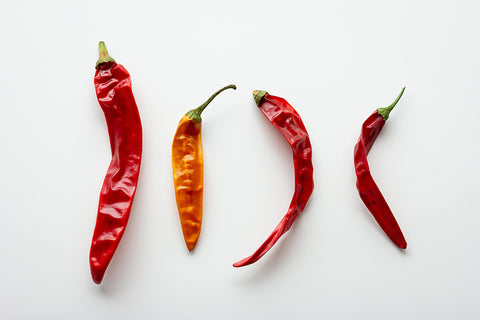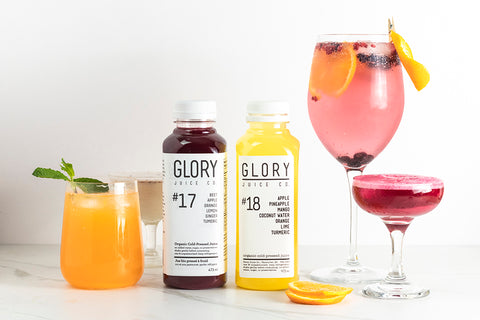Remember going to your grandparent's house and their cupboards were stocked-full with preserved goods of all kinds, some even unidentifiable? I bet they're doing well right now.
The act of preserving, whether canning, jarring or simply freezing, is an underutilized craft. But now, with our period of social distancing continuing to extend, it's the perfect time to make your pantry and freezer chockablock full of preserved goods.
In true Glory Juice Co. fashion, we’re keeping it vegan and outlining the 4 best ways to preserve fruits and vegetables. This can help you limit the amount of purchasing you do (and the stress of throwing out wilted goods!).
Like most things, you get what you put into it, and it's best to use the best produce and ingredients, if possible.
Canning

This method allows you to buy produce in peak growing season and then preserve to consume later. Most use either a pressure canner or water bath canner. Though all you need is a large pot and rack at the bottom to keep the jars separated and from not touching the bottom.
*Disclaimer* It's important to reduce the risk of bacteria for long-term storage. Harmful bacteria are killed when the product is in the jar and boiled to 240 degrees. The higher the acidity in the product the lower the risk of botulism and the lower the PH the higher the chance of botulism. Add lemon juice or apple cider vinegar if you're worried the PH is too low.
How to can fruits or vegetables:
1. Chop or slice your fruit or vegetable of choice.
2. Prepare produce of choice:
Vegetables: Create brine by using two parts vinegar to one part water. (i.e. 2 cups Pure white vinegar + 1 cup water.) You can also add spices for enhanced flavour.
Fruit: You can simply can fruit in water as long as the fruit has been soaked in citric acid (lemon juice). Add sugar to help further preserve and add flavour.
Jam: Add desired fruit with sugar, lemon juice, and salt over high heat. When boiling mash down into jam. (Make sure jars are hot as the hot jam will cracked a cold jar)
3. Sanitize jars in the dishwasher (take one jar out at a time to keep them warm). The jars could also be boiled if you don't have a dishwasher.
4. Fill jar, leaving headspace and remove any air pockets.
5. Once all jars are filled put lids on and submerge them in water with 2 inches of water covering the vessels. The water must reach 212 degrees Fahrenheit for high PH produce and 240 degrees for low PH to kill harmful bacteria. (The jars must not sit directly on the bottom of the canner or touch each other)
6. Maintain the two inches by adding boiling water to the pot.
7. When your time is up and reached 212-240 degrees, turn off the heat. Carefully raise the rack and jars up. Wait a minute or two before you take your jars out of the canner.
8. Let rest on a towel or cutting board for 12-24 hours.
9. After the rest period, test seal by pressing down on top.
10. Label the jar with the food type, date and then store.
Get a head start on canning with these recipes.
Drying

Drying fruits or vegetables allows you to make your favourite spices and dried fruits at home. All you need is a dehydrator or an oven.
Almost all fruits and vegetables can be dried, some take more time with the amount of moisture they have and their cut. It takes less energy and space to store than freezing and canning. Flavours become more concentrated and the fibre remains. Some even say the minerals and nutrients last longer than other preservation methods.
How to dry fruits or vegetables:
- Slice you preferred fruit or vegetable of choice in thin, even amounts. Remove seeds or pits. (Different cuts and types of fruit or vegetables have different drying times).
- Soak in citric acid (lemon juice) to cure.
- Preheat oven to 200 Fahrenheit or 150 Fahrenheit if your oven can go down that low. (Keep door open 3 inches if on the higher heat to let moisture escape)
- Put product on parchment paper-lined baking sheet and put in oven
- Flip product every 30 minutes.
- When ready remove and place in an open container for 4-5 days to remove any moisture.
Freezing

How to freeze vegetables or fruits:
- Before freezing vegetables, blanch and shock vegetables, by boiling them briefly, drain, then plunge into ice water. Then dry thoroughly.
- (If possible): spread them in a single layer on a rimmed sheet pan and flash freeze them.
- Transfer product to air-tight containers or freezer bags. Removing any excess air as possible. Be sure to date the packages.
- For best quality only leave in freezer for about 18 months. Hopefully we're able to go outside by then!
A few tips on freezing:
- Fruits and veggies freeze best at 0-degrees F or colder.
- Vegetables that hold up well to cooking (corn, peas) generally freeze well.
- For better texture, use frozen fruit in recipes before it's completely thawed
Fermentation
Fermentation is essentially the controlled rot of vegetables. It has beneficial factors that help aid digestion and boost the immune system. Almost any vegetable can be fermented and all you need is water, salt, vegetables and a vessel to hold it. You could ferment one alone or create a vegetable medley.
How to ferment fruits or vegetables:
- Chop, grate, slice or leave whole your fruits, or vegetables, of choice.
- Create the brine for the vegetables to sit in. Using filtered water is essential and the best quality salt. Making the brine begins Lacto-fermentation. The salt kills all the bad bacteria and leaves us with the good. For every 100 grams of vegetables use 2 grams of salt. (You can even add spices and herbs to the brine for more flavour.
- Submerge vegetables, or vegetables, in the brine in your choice of vessel. You can choose a fermentation grade jar or even a fermentation crock. Make sure vegetables are fully beneath the liquid. (Make sure you "burp" the vessel of gases, as it can blow up of you don't.)
- Leave out at room temperature. Check after three days and if you want them more acidic, leave it out longer. Once you're happy, move them to the fridge.
Fermentation requires some trial and error to get the taste and texture right. But we've got time! This could be the perfect chance for you to give it a shot and perfect a recipe.
Some popular fermented products include kombucha and kimchi. Here's a great video series on fermentation and some additional recipes for you to get started.
Don't feel like preserving food yourself? We've added 30-day shelf life to all our juices and launched a new line of frozen, ready-to-blend smoothies. Get them delivered today!




Comments (0)
There are no comments for this article. Be the first one to leave a message!